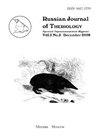Copulatory behavior supports a new insight into taxonomic status of root vole Alexandromys oeconomus (Rodentia, Arvicolinae)
IF 0.6
4区 生物学
Q4 ZOOLOGY
引用次数: 3
Abstract
The aim of the study was to evaluate the phylogeny and relationships of the root vole Alexandromys oeconomus with the other species of the tribe Microtini, using the comparison of the characteristics of sexual behavior. Thirteen copulatory behavior patterns that form a specific stereotype of the species’ mating behavior are used. The results showed the multiple thrusting stereotype of copulation, which includes separate intromissions and a very first mount with intromission, is ending with ejaculation (from 10% to 48%, depending by the investigated population). The number of ejaculations is comparatively big, varying from 4 to 7 (an average of 4.6) and the genital stimulation rate is from 68 to 260 thrusts. The males of the root vole noted active courtship for the female, which is accompanied by singing, waltzing and marking of the substrate. Marking the territory is manifested by rubbing the femoral region on the substrate, in which the secretion of the hip glands is applied to it. Analysis of the distances (or similarities) between species according to patterns of sexual behavior using the method of cluster analysis indicates the proximity of A. oeconomus to species of the genus Alexandromys and a considerable distance from representatives of the genus Microtus (Microtus s.str. and Sumeriomys). Significant interpopulation differences in copulatory behavior of the Central Asian phylogroup are established (54% of all the behavioral traits studied). The transformation of the stereotype of mating in individuals from Beringia phylogroup in comparison with the Central Asian one is particularly significant and reaches 77% of all the behavioral traits. The data obtained by the analysis of the copulatory behavior of the Alexandromys oeconomus support the separation of the species from genus Microtus. How to cite this article: Zorenko T.A., Atanasov N.A. 2018. Copulatory behavior supports a new insight into taxonomic status of root vole Alexandromys oeconomus (Rodentia, Arvicolinae) // Russian J. Theriol. Vol.17. No.1. P.48–57. doi: 10.15298/rusjtheriol.17.1.05交配行为支持对根田鼠分类地位的新认识(啮齿目,根田科)
摘要本研究旨在通过性行为特征的比较,探讨根田鼠亚历山鼠(Alexandromys oeconomus)与其他物种的系统发育及其亲缘关系。13种交配行为模式形成了物种交配行为的特定刻板印象。结果显示,多次插入的刻板印象,包括单独插入和第一次插入,以射精结束(从10%到48%,取决于调查人群)。射精次数相对较多,从4到7次不等(平均4.6次),生殖器刺激率从68到260次不等。根田鼠的雄性注意到雌性主动求爱,伴随着唱歌、华尔兹和在基底上做标记。标记领地是通过在基底上摩擦股区域来表现的,在基底上涂抹臀部腺的分泌物。利用聚类分析的方法根据性行为模式对物种间的距离(或相似度)进行分析,结果表明,大褐家鼠与Alexandromys属的物种接近,与田鼠属的代表物种(Microtus s.str.)有相当大的距离。和Sumeriomys)。中亚种群的交配行为存在显著的种群间差异(占所有研究行为特征的54%)。与中亚种群相比,白令陆桥种群个体交配刻板印象的转变尤为显著,达到所有行为特征的77%。对亚历山螨交配行为的分析支持了亚历山螨从鼠属中分离出来的观点。如何引用本文:Zorenko t.a., Atanasov N.A. 2018。交配行为支持对根田鼠分类地位的新认识//俄罗斯J. Theriol。Vol.17。第一。P.48-57。doi: 10.15298 / rusjtheriol.17.1.05
本文章由计算机程序翻译,如有差异,请以英文原文为准。
求助全文
约1分钟内获得全文
求助全文
来源期刊

Russian Journal of Theriology
Agricultural and Biological Sciences-Animal Science and Zoology
CiteScore
0.90
自引率
33.30%
发文量
0
期刊介绍:
The Russian Journal of Theriology publishes papers on all aspects of mammalian biology: taxonomy, zoogeography, ecology, behavior, morphology, development, physiology, paleontology, and evolution. Studies of extinct as well as extant taxa are included. Reviews are also published; these may be invited by the Editorial Board.
 求助内容:
求助内容: 应助结果提醒方式:
应助结果提醒方式:


